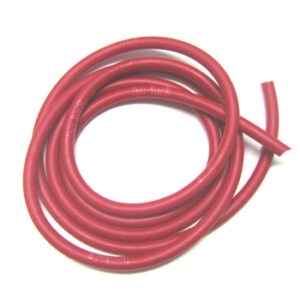Diagnostic Guide – Elbow & Forearm Pain
Updated:
Patients suffering from elbow pain or forearm pain are often seen in physiotherapy practice. Pain may be caused by local structures within or around the elbow or may be referred from other sources (such as the neck or upper back).
One of the most common clinical presentations is the patient suffering from gradual onset outer elbow pain due to overuse of the wrist / forearm extensor muscles (figure 1) during gripping activities (e.g. in manual workers or sports people). This typically causes gradual degeneration of the tendons where they attach to the outer elbow (lateral epicondyle – figure 1) and is known as extensor tendinopathy, or, more commonly, Tennis Elbow. There are numerous other causes of elbow pain and forearm pain, some of which present suddenly due to a specific incident, others which develop gradually over time.

Below are some of the more common causes of pain in the elbow and forearm region with a brief description of each condition to aid diagnosis.
Find out what may be causing your elbow or forearm pain:
Sudden Onset Elbow & Forearm Pain – Common Injuries
Tennis Elbow (Lateral Epicondylitis)
Degeneration and inflammation of the wrist / forearm extensor tendons where they attach to the outer aspect of the elbow (lateral epicondyle – figure 1). Associated with elbow pain or ache at the outer aspect of the elbow, tenderness on firmly touching the affected tendons and often pain and stiffness first thing in the morning. Usually an overuse injury, but occasionally may present suddenly due to a specific incident.
Golfers Elbow (Medial Epicondylitis)
Degeneration and inflammation of the wrist / forearm flexor tendons where they attach to the inner aspect of the elbow (medial epicondyle – figure 2). Associated with pain or ache at the inner aspect of the elbow, tenderness on firmly touching the affected tendons and often pain and stiffness first thing in the morning. Usually an overuse injury, but occasionally may present suddenly due to a specific incident.
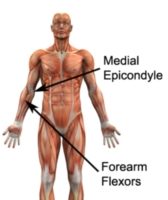
Referred Pain
Pain referred into the elbow and forearm from another source such as the neck or upper back, frequently associated with symptoms above or below the elbow and forearm (such as the shoulder, arm, wrist or finger) and in the referring area (e.g. neck or upper back pain / stiffness). Typically associated with pain on firmly touching the region responsible for the referred pain and / or loss of movement in that region. Sometimes in association with pins and needles or numbness in the affected arm or hand.
MCL Tear
Tearing of the medial collateral ligament of the elbow (figure 3) typically following a sideways force to the elbow (valgus force – figure 4) and associated with pain on firmly touching the affected ligament and often swelling. A snap or tear may be audible during injury.
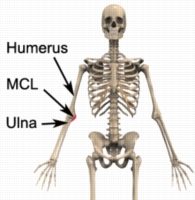
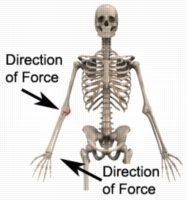
Less Common Sudden Onset Injuries
Olecranon Fracture
Fracture of the bony process at the back of the elbow (Olecranon – figure 5) usually due to traumatic forces (e.g. a direct blow to the back of the elbow or fall onto an outstretched hand). Associated with severe elbow pain, swelling and tenderness on firmly touching the affected region of the bone.
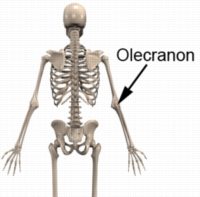
Figure 5 – Olecranon Anatomy
Radial Head Fracture
Fracture of the head of the radius bone (figure 6) located just below the elbow joint at the outer aspect of the elbow usually due to traumatic forces (e.g.a fall onto an outstretched hand). Associated with severe elbow pain, swelling and tenderness on firmly touching the affected region of the bone.
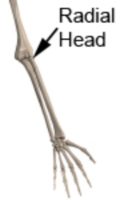
Supracondylar Fracture
Fracture of the upper arm bone (humerus) just above the elbow joint (Supracondylar Region – figure 7) usually due to traumatic forces (e.g.a fall onto an outstretched hand). Associated with severe pain, swelling and tenderness on firmly touching the affected region of the bone.

Ulna Fracture
Fracture of the inner forearm bone known as the ulna (figure 8) usually due to traumatic forces (e.g. a fall onto an outstretched hand). Associated with severe elbow pain, swelling and tenderness on firmly touching the affected region of the bone.
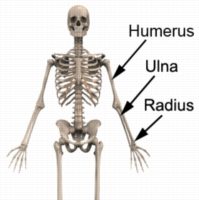
Biceps Tendon Rupture
Rupture of the biceps tendon (figure 9) associated with sudden onset pain at the front of the elbow usually due to a specific incident (e.g. weight lifting), followed immediately with marked loss of function and weakness on attempting to lift or perform a bicep curl. A snap or tear may be audible during injury. Swelling and tenderness on touching the tendon is typically present.
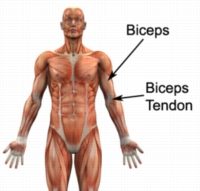
Dislocated Elbow
Separation of the elbow joint due to traumatic forces (e.g. fall from a height or due to a collision in contact sports) with severe elbow pain, loss of function, swelling, deformity and often associated with one or more fractures
Ulnar Nerve Compression
Compression of the ulnar nerve as it passes the inner aspect of the elbow (figure 10) often due to a direct impact or repetitive stresses. Associated with pain at the back / inner aspect of the elbow and forearm with pins and needles or numbness in the little finger and half of the ring finger. Tenderness may also be present on firmly touching the ulnar nerve at the inner aspect of the elbow.
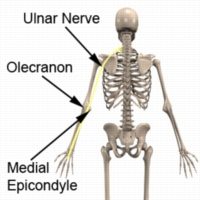
Gradual Onset Elbow & Forearm Pain – Common Injuries

Members Only ContentBecome a PhysioAdvisor Member to gain full access to this exclusive content. For more details see Become a Member. Already a member? Login Now
Less Common Gradual Onset Injuries

Members Only ContentBecome a PhysioAdvisor Member to gain full access to this exclusive content. For more details see Become a Member. Already a member? Login Now
Diagnosis of elbow & forearm pain
A thorough subjective and objective examination from a physiotherapist is usually sufficient to diagnose the cause of elbow pain or forearm pain. Investigations such as an X-ray, ultrasound, MRI, CT scan or nerve conduction studies are often required to confirm diagnosis and rule out other injuries.
Find a Physio for elbow & forearm pain
Find a physiotherapist in your local area who can diagnose and treat patients suffering from elbow pain and forearm pain.
More Information
- View Elbow Stretches.
- View detailed information on initial injury management and the R.I.C.E Regime.
- View detailed information on when to use Ice or Heat?.
- View detailed information on Elbow Taping.
Physiotherapy products for elbow & forearm pain
Some of the most commonly recommended products by physiotherapist for patients with elbow pain and forearm pain include:
To purchase physiotherapy products to assist with rehabilitation click on one of the above links or visit the PhysioAdvisor Shop.

Link to this Page
If you would like to link to this article on your website, simply copy the code below and add it to your page:
<a href="https://physioadvisor.com.au/injuries/elbow-forearm”>Diagnostic Guide – Elbow & Forearm Pain – PhysioAdvisor.com</a><br/>PhysioAdvisor provides a diagnostic guide for patients suffering from elbow pain or forearm pain created by experienced physiotherapists.
Return to the top of Diagnostic Guide – Elbow & Forearm Pain.




